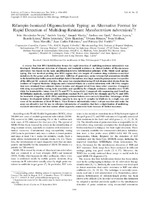Please use this identifier to cite or link to this item:
http://sgc.anlis.gob.ar/handle/123456789/307| Title: | Rifampin-Isoniazid Oligonucleotide Typing: an Alternative Format for Rapid Detection of Multidrug-Resistant Mycobacterium tuberculosis | Authors: | Hernandez-Neuta, Iván Varela, Andres Martin, Anandi von Groll, Andrea Jureen, Pontus López, Beatriz Imperiale, Belen Skenders, Girts Ritacco, Viviana Hoffner, Sven Morcillo, Nora Palomino, Juan Carlos Del Portillo, Patricia |
Keywords: | Rifampin;Sondas de Oligonucleótidos;Mycobacterium tuberculosis;Tuberculosis Resistente a Múltiples Medicamentos | Issue Date: | Dec-2010 | Publisher: | American Society for Microbiology | Journal: | Journal of clinical microbiology | Abstract: | on of rifampin and isoniazid resistance in clinical isolates of Mycobacterium tuberculosis was based on the same amplification/reverse hybridization principle of the widely used spoligotyping. The test involved probing nine DNA regions that are targets of common drug resistance-associated mutations in the genes rpoB, katG, and inhA. Addition of quaternary amine tetramethyl ammonium chloride to the hybridization buffer promoted multiple hybrid formations at a single annealing temperature irrespective of the different GC contents of probes. The assay was standardized using 20 well-documented strains from the Institute of Tropical Medicine (Belgium) and evaluated blindly in a central laboratory with 100 DNA samples that were obtained from cultured clinical isolates and shipped dried from three other countries. Compared with drug susceptibility testing, both sensitivity and specificity for rifampin resistance detection were 93.0% while for isoniazid the values were 87.7% and 97.7%, respectively. Compared with sequencing and GenoType MTBDRplus methods, sensitivity and specificity reached 96.4% and 95.5% for rifampin and 92.7% and 100% for isoniazid. Altogether, 40/45 (89%) multidrug-resistant isolates were correctly identified. Advantages of this in-house development include versatility, capacity to run up to 41 samples by triplicate in a single run, and reuse of the membrane at least 10 times. These features substantially reduce cost per reaction and make the assay an attractive tool for use in reference laboratories of countries that have a high burden of multidrug-resistant tuberculosis but that cannot afford expensive commercial tests because of limited resources. |
Description: | Fil: Hernandez-Neuta, Iván. Corporacion CorpoGen; Colombia. Fil: Varela, Andres. Corporacion CorpoGen; Colombia. Fil: Martin, Anandi. Institute of Tropical Medicine. Mycobacteriology Unit; Bélgica. Fil: von Groll, Andrea. Institute of Tropical Medicine. Mycobacteriology Unit; Bélgica. Fil: Jureen, Pontus. Swedish Institute for Infectious Disease Control; Suecia. Fil: López, Beatriz. ANLIS Dr.C.G.Malbrán. Instituto Nacional de Enfermedades Infecciosas; Argentina. Fil: Imperiale, Belen. Hospital Dr. Cetrángolo; Argentina. Fil: Skenders, Girts. State Agency of Tuberculosis and Lung Diseases; Letonia. Fil: Ritacco, Viviana. ANLIS Dr.C.G.Malbrán. Instituto Nacional de Enfermedades Infecciosas; Argentina. Fil: Hoffner, Sven. Swedish Institute for Infectious Disease Control; Suecia. Fil: Morcillo, Nora. Hospital Dr. Cetrángolo; Argentina. Fil: Palomino, Juan Carlos. Institute of Tropical Medicine. Mycobacteriology Unit; Bélgica. Fil: Del Portillo, Patricia. Corporacion CorpoGen; Colombia. |
URI: | http://sgc.anlis.gob.ar/handle/123456789/307 http://jcm.asm.org/content/48/12/4386.full.pdf+html |
ISSN: | 1098-660X | Rights: | info:eu-repo/semantics/openAccess Creative Commons Attribution 4.0 International License |
| Appears in Collections: | snrd Publicaciones INEI |
Files in This Item:
| File | Description | Size | Format | |
|---|---|---|---|---|
| JournalofClinicalMicrobiology,2010,48(12),4386–4391..pdf | Artículo en inglés | 981.75 kB | Adobe PDF |  View/Open |
Page view(s)
206
checked on Dec 16, 2025
Download(s)
94
checked on Dec 16, 2025
Google ScholarTM
Check
This item is licensed under a Creative Commons License


